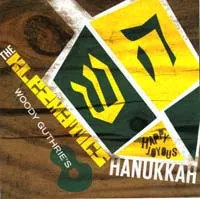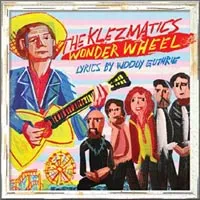HOLY GROUND: Woody Guthrie's Yiddish Connection


Woody Guthrie lived in Coney Island, Brooklyn, across the street from his mother-in-law, the Yiddish poet, Aliza Greenblatt. They shared their dreams and their art, their neighborhood and a family. Klezmatics
trumpeter Frank London says, “each of us
found our own way to confront Woody's poetry. The words are all
his, but the diversity of musical styles is quintessentially Klezmatic.”
London says that some songs lent themselves to overtly Jewish klezmer
music, others to more American forms, like classic dust-bowl country
tunes. Some felt brand new to the musicians, while others felt more
like folks songs “that had been around forever.” The
band’s influences in setting the lyrics to music ranged from
sacred (Hasidic nigunim --wordless tunes often used in prayer –
and Gospel) to secular (freylekhs – traditional dance music
– and hoedowns).”The Yiddish Connection Guthrie’s
Jewish lyrics can be traced to the unusual collaborative relationship
he had with his mother-in-law, Aliza Greenblatt,
a prominent Yiddish poet who lived across from Guthrie and his family
in Brooklyn in the 1940s. Guthrie – the Oklahoma troubadour
– and Greenblatt – the Jewish wordsmith – often
discussed their artistic projects and critiqued each other’s
works, finding common ground in their shared love of culture and
social justice, despite very different backgrounds. Their collaboration
flourished in 1940s Brooklyn, where Jewish culture was interwoven
with music, modern dance, poetry and anti-fascist, pro-labor activism.
Woody Guthrie’s Jewish lyrics came as a surprise to Nora
Guthrie, director of the Woody Guthrie Archives and Woody’s
daughter. She became aware of his connection to Judaism only recently,
in a chance encounter with the Klezmatics and Itzhak Perlman.
Following a concert at Tanglewood, where (unbeknownst to Nora) Perlman
and the band had performed some of Greenblatt’s Yiddish songs,
Guthrie was introduced to Perlman as “Aliza’s granddaughter.”
She recalls, “All my life, I’ve been introduced as Woody’s
daughter, Arlo’s sister and Marjorie Mazia’s daughter…but
this was the first time I’d ever been introduced as ’Aliza
Greenblatt’s granddaughter!’ Then Itzhak asked me how
I liked his version of Aliza’s song – I almost fell
through the floor. I never knew she wrote songs – I always
thought she was just my Bubbie!” The revelation about her
grandmother’s history encouraged Nora Guthrie to bring her
father’s Jewish songs to light, and she enlisted the Klezmatics
– one of the world’s preeminent klezmer groups – in the project that comes to fruition in this concert at the 92nd
Street Y.
The Klezmatics
perform around the world, and wrote music for Tony Kushner’s
A Dybbuk and Pilobolus Dance Theater’s Davenen. They have
recorded twice with Itzhak Perlman and collaborated with poet Allen
Ginsberg and Morocco’s Master Musicians of Jajouka. Their
latest CD, Rise Up! Shteyt Oyf! (Rounder) was released in September
to critical acclaim, particularly for their bilingual version of
Holly Near's anti-fundamentalist "I Ain't Afraid."Woody,
Martha Graham and Coney Island's Jewish Community Woody
Guthrie, dust bowl balladeer, and Aliza Greenblatt,
his Yiddish poet mother-in-law came together when Martha
Graham dancer Marjorie Mazia (Greenblatt’s
daughter) happened to meet Guthrie when one of Graham’s choreographers
set a dance to his lyrics. Here is the story of how their unlikely
collaboration unfolded.
Woody Guthrie was born in 1912 and came to New York in 1940, after
years in Oklahoma and Los Angeles, where he wrote many of the songs
that would later appear on his landmark record Dust Bowl Ballads.
In New York, Guthrie found himself surrounded by like-minded artists
like Leadbelly (Huddie Ledbetter), Pete Seeger, Sonny Terry and
Brownie McGhee, who all fought for social justice through political
protest songs.In the 1940s, Guthrie’s songs were recorded
by folklorist Alan Lomax, working at the Library of Congress, and
Moses Asch of Folkways Records. These recordings came to the attention
of Sophie Maszlow, a dancer with the Martha Graham Dance Company.
Maslow used some of them in her ballet Folksay, a historic suite
of dances choreographed to American roots music in its original
(i.e. non-concertized) form.
Days before
the premier of the ballet, Maslow and Marjorie Mazia, another dancer
with the Martha Graham troupe, heard that Guthrie was in New York,
and together went to his Greenwich Village apartment with an invitation
to accompany the troupe live. According to Guthrie family legend,
Marjorie, already a huge fan of Woody’s ballad “Tom
Joad” took one look at him and silently declared, “that’s
the guy I’m going to marry. And I’m going to have his
children!”Mazia’s
initial impulse was right on target, and the two eventually married
in 1945, after they had been living together for several years.
They moved to Coney Island in 1942, and there, in the heart of Brooklyn’s
Jewish community, he lived across the street from his mother-in-law,
Aliza Greenblatt, who introduced him to Jewish culture and history.
Whatever their differences in religious upbringing, Guthrie and
Greenblatt shared a passion for social justice, anti-fascism and
union organizing – all causes dear to the Jewish community.
Greenblatt
played a major role in the Guthrie family’s life; known to
them as “Bubbie,” she cared for her grandchildren and
served Friday night Sabbath dinners to the family. She had a profound
influence on Arlo Guthrie, her oldest grandson, whose 1960s hit
Alice’s Restaurant catapulted the younger Guthrie into a decades-long
career as an internationally known songwriter, singer and activist.
In addition to sharing their family life, Greenblatt and Guthrie
developed a professional relationship, sharing their stories, poems
and lyrics; Guthrie was inspired to write songs that came directly
out of this unlikely relationship, both personal and political;
he clearly identified the Jewish struggle with that of his fellow
Okies and other oppressed and disenfranchised peoples.
Woody
Guthrie wrote Hanukkah songs for parties at the local Jewish community
centers, he wrote songs about Jewish history and spiritual life
and about World War II and the anti-fascist cause. Nora Guthrie
is committed to preserving and promoting her father’s work,
shaking up people’s perceptions of him in the process. “He
was a poet and lyricist who wrote about everything. I don’t
want to see him turned into a freeze-dried, Dust Bowl icon representing
a narrow version of what somebody thinks he was. These songs are
just one more facet of his work that will add to a fuller picture
of him as a songwriter.”Guthrie
ended up living in New York for a period of 27 years, longer than
he lived anywhere else. He died in 1967 after spending 15 years
in New York City hospitals battling Huntington’s Disease.
This project, HOLY GROUND, explores and honors the unusual connection
between these unlikely relatives – the Dust Bowl Balladeer
and his mother-in-law, the Yiddish poet.